|
1.
CENTRAL AND WEST AFRICA
Congo suspends log exports
Boris Ngounou, writing for Afrik21, reports that the
Republic of Congo suspended log exports as of 1 January
2023. This decision is despite guidelines from the Council
of Ministers of the Central African Economic Union
(UEAC) which decided on 28 October 2022 to postpone,
to an unspecified date, the entry into force of the log
export ban. Cameroon continues to export logs say
Ngounou.
Pointe-NoirePport officials are following instructions from
the Congolese Minister of Forest Economy, Rosalie
Matondo, who announced in a letter dated 21 October
2022 that from 1 January 2023 wood product exports from
Congo would be restricted to semi-finished or finished
products.
While not adopting a log export ban it is reported that the
government in Cameroon has significantly increased
duties and export taxes on logs which prompted some
operators to stop production as of 2 January 2023.
See:
https://www.afrik21.africa/en/congo-ban-on-export-oftimber-in-log-form-comes-into-force/
Buyers tighten demandsfor CITES documentation
Producers in other Cemac countries are seeking
clarification as there has been no official announcement on
whether the export restrictions are in place. Similarly,
producers are yet to learn of the implementation plans for
the latest CITES regulations but report that already
European authorities are asking for CITES documents
without which shipments will be detained until all papers
are cleared. It has been learned that the authorities in
Antwerp are particularly strict which has resulted in some
cargo to be redirected to Amsterdam.
The challenge of added value manufacturing
With the lifting of most covid restrictions in China
producers in the region are optimistic that demand in
China will pick up after the Chinese New Year holidays.
What has many concerned is how to contribute to the
efforts in expanding domestic processing of added value
products. There has been an increase in processing in
Congo and Cameroon and efforts are being made to
manufacture furniture, mainly for the domestic market, to
compete with imports.
Weak demand – mills cut production
It has been reported that in Gabon there are some 234
mills of which 167 are Chinese owned but due to the weak
demand in China 34 peeler mills has ceased production.
However most of the Indian mills are still operating and
production rates have increased as efforts to diversify
markets are paying off.
Demand for ovangkol, padouk, belli for the Chinese
market is holding up and buyers for the Philippines and
Middle East markets are active. However, demand for tali
for the Vietnamese market is said to be soft.
The high stock of okoume in the Gabon SEZ has not been
resolved and there are reports of additional and massive
log stocks in the forest concession areas.
Log transport is a constant issue in Gabon. Most logs are
transported by rail but log shipment take second place
after manganese shipments. Transportation delays will
continue as landslides have damaged large stretch of the
rail line and repairs will take months.
See:
https://www.lenouveaugabon.com/fr/transportslogistique/2812-19328-transport-ferroviaire-la-date-de-reprisedu-trafic-sur-le-transgabonais-toujours-pas-connue
In other news from Gabon, the local media has report the
President as announcing that retirement pension arrears
will be fully paid from January 2023. This may ease the
tensions in the Forest authority which has been plagued by
strike action in recent months.
See:
https://www.lenouveaugabon.com/fr/social/0201-19336-alibongo-promet-de-regler-integralement-les-arrieres-de-pensionsde-retraite-des-ce-mois-de-janvier
What prospects for certified tropical timber in 2023?
The 5th ATIBT ‘Think Tank’ on 7 and 8 December
addressed three themes: Carbon finance and Biodiversity,
Improving the image of tropical timber in Europe and
Exploring new markets for tropical timber. To find the
presentations see:
https://www.atibt.org/fr/resource-categories/29/atibt-think-tankn5-2022
EU timber regulation (EUDR)
The ATIBT has reported that Preferred by Nature is
organising 2 webinars on the new EU deforestation
regulation, one in French on Wednesday, 25 January from
12:00 to 13:15 CET, the other in Spanish on Thursday, 26
January from 15:00 to 16:15 CET.
Registration: contact Julie Thirsgaard Hansen
jhansen@preferredbynature.org.
See: https://www.atibt.org/en/announcements/159/preferred-bynature-
is-organizing-two-new-webinars-in-french-and-spanishon-
the-eudr
Also, the ATIBT has carried out 12 Life Cycle Impact
Assessments (LCIA) for the main certified wood products
from the Congo Basin. The results of these 12 LCIAs are
now available in English.
See: https://www.atibt.org/en/resource-categories/28/life-cycleassessment-
of-congo-basin-timber
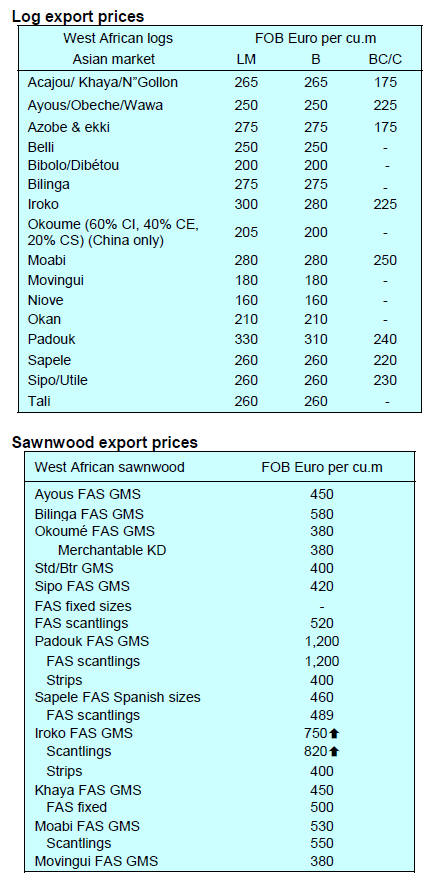
2.
GHANA
First 9-months wood exports up in volume and value
Wood product exports in the first nine months of 2022
were 267,512 cu.m with a cumulative revenue of
Eur117.14 million according to data from the Timber
Industry Development Division (TIDD) of the Forestry
Commission (FC). This is a jump of 19% in volume and
13% in value compared to the same period in 2021.
The data show that, of the 15 wood products exported, the
top five were air and kiln dried sawnwood (68%), billet
s(12%), plywood for the regional market (10%) and sliced
veneer (3%) with 10 other products accounting for the
balance.
The graph below shows the wood export by product;
Leading wood product exports (Volumes, Jan-Sep 2022)
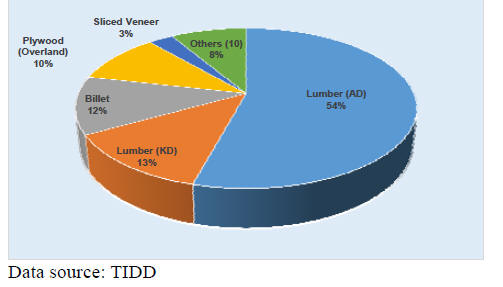
According to the TIDD report there were eighty-two
exporters in September 2022 of which the top five
exported ten different wood products from forty species to
thirty-eight countries.
The leading species in terms of volume were teak, ceiba,
wawa, denya, and black ofram. The main markets were
India, Togo, Burkina Faso, Germany and Vietnam.
Chenchen recorded the highest decline in volume in the
first three quarters of 2022 dropping by over 45%.
The average unit price of products exported for the period
January to September 2022 decreased to Eur438 per cu.m,
from the previous Eur460 per cu.m recorded in January to
September 2021.
Product exports by category
The table below shows the breakdown of the wood
products exported from Ghana as primary, secondary and
tertiary which accounted for tall shipments for the period.

Primary products, mainly billets, contributed 31,302 cu.m
(12%) and Eur10.07 million (9%) in volume and value
respectively in the first three quarters of 2022.Secondary
products being the largest group comprised of sawnwood,
boules, veneers, plywood and briquettes and contributed
229,055 cu.m (86%) and Eur101.76 million (87%) to
earnings in the period January to September 2022.
Exports of tertiary products, consisting of moulding and
dowels, contributed 7,154 cu.m and Eur5.31million in
volume and value respectively in the first three quarters of
2022. For the period under consideration the volumes of
primary and tertiary products dipped in 2022 when
compared to 2021. However, the proportion of secondary
products increased to 86% in 2022 from 80% recorded in
2021.
It is the aim of government to transform the industry away
from exports of primary to exports of value added
products and this could explain the higher volumes for
4 ITTO TTM Report: 27:1 1 - 15 Jan 2023
secondary products which account for over 80% of total
export volumes. Tertiary product exports have been lower
than expected due to the general economic operational and
technical bottlenecks affecting the manufacturing sector.
Government to support private plantation developers
Government has assured the private sector that support
and cooperation will be provided if they participate in
establishment of commercial forest plantations to create an
industrial timber resource and help restore degraded forest
landscapes.
The Minister for Lands and Natural Resources, Samuel A.
Jinapor, said this during a forum on loan scheme
awareness for private plantation developers in the Ashanti
Region of Ghana. The Forum was organised by the Ghana
Forest Investment Programme (GFIP) under the auspices
of the Ministry of Lands and Natural Resources,
Mr. Jinapor assured participants of the government’s full
backing and encouraged developers to actively get
involved.
In a related development, Ghana has obtained US$486.2
million as first payment from carbon sales.
See:
https://www.ghanaweb.com/GhanaHomePage/business/Ghanagets-486-2-million-from-carbon-sale-1680389
Ghana/UK Business Council supports bilateral trade
The Vice President, Dr. Mahamudu Bawumia, has hailed
the efforts of the UK-Ghana Business Council (UKGBC)
established to enhance trade and cooperation between the
Governments of Ghana and the United Kingdom.
Speaking at the 7th session of the Council Dr. Bawumia
said the UKGBC has helped Ghana benefit from the
funding for major infrastructure projects. He emphasised
that both the UK and Ghana continue to deepen and
increase bilateral ties on trade and investment. The UK is a
leading importer of Ghana’s wood products including
sawnwood, mouldings, veneers and briquettes.
See:
https://www.myjoyonline.com/bawumia-hails-impact-ofuk-ghana-business-council-on-ghanas-infrastructuredevelopment/

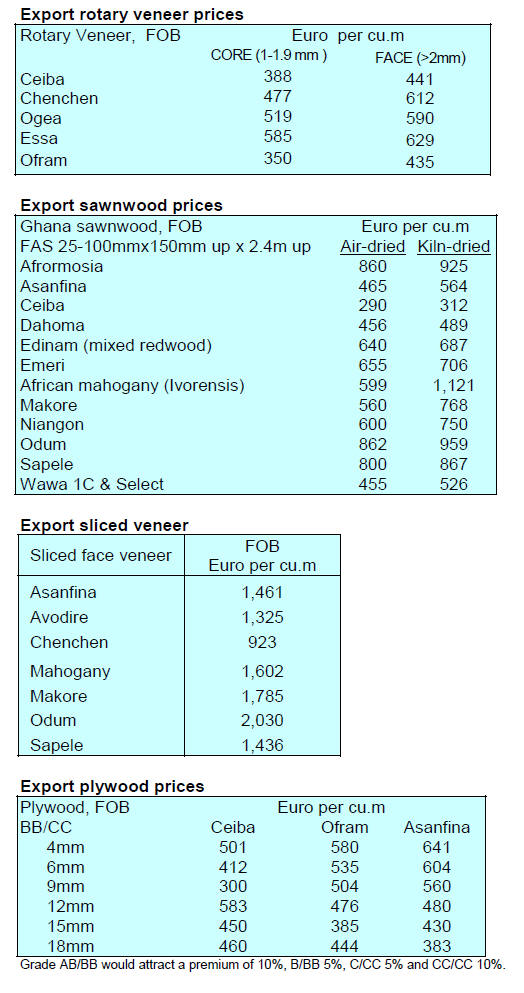
3. MALAYSIA
Moderate growth forecast
The economy is expected to grow by only 4% this year
due to the negative impact of moderating exports but could
be held up by normalisation of domestic demand and
success in taming domestic inflation. However, the impact
of higher interest rates will eventually have an impact on
consumption. It is expected that Bank Negara is unlikely
to shift from monetary tightening policies in 2023.
See:
https://www.thestar.com.my/business/businessnews/2023/01/10/moderate-growth-for-2023
Free and fair trade at risk
The Malaysian Timber Council has reported Deputy Prime
Minister, Datuk Seri Fadillah Yusof’s concerns on the
European Council’s decision on the EU Deforestation-
Free Products Regulation as this will include commodities
including palm oil, timber, cocoa and rubber.
The Deputy Prime Minister said the unilateral initiative is
detrimental to free and fair trade and could result in
adverse effects on the global supply chain.
See:
https://mtc.com.my/images/media/1350/DPM_Fadillah_states_M
alaysia---s_concern_over_new_EU_green_law_targeting_commodities___Malay_Mail.pdf
The Malaysian Prime Minister, Anwar Ibrahim, recently
met his Indonesian counterpart and discussed economic
cooperation and regional security issues. Indonesia and
Malaysia have decided to work together to defend their
exports of palm oil, a commodity included in the EUDR
(European Union Deforestation Regulation). The leaders
agreed to work to promote the commodity through the
Council of Palm Oil Producing Countries.
See: https://www.trtworld.com/magazine/why-indonesia-andmalaysia-
are-calling-out-eu-discrimination-64314
In related news, Sabah Timber Industries Association
(STIA) president Tan Peng Yuan has warned the timber
industry will be facing challenges in the coming year, one
of which is timber certification.
The STIA is concerned that the EU will be enforcing
additional requirements under the EUDR that may limit
Sabah’s products access into the market. If market access
is restricted the impetus for investment in both planting
and manufacturing could be lost, he said. According to
Tan, Sabah is well advanced with the state’s TLAS
certification system which was developed through a welldefined
Chain-of-Custody process.
See:https://www.theborneopost.com/2023/01/08/sabah-timberindustry-
to-face-certification-challenge/
Rules covering recruitment of foreign workers eased
The government has eased the rules for covering
recruitment of foreign workers. The Prime Minister (PM)
said the new ‘Plan to Facilitate the Hiring of Foreign
Workers’ (Pelan Kelonggaran Penggajian Pekerja Asing)
will allow employers to hire foreign labour without
constraints or any preconditions or quotas.
A Malaysian delegation will be organised to visit countries
to discuss matters related to the safety and wellbeing of
foreign workers in Malaysia according to the PM.
See: https://www.theborneopost.com/2023/01/10/pm-anwarputrajaya-
eases-rules-on-the-hiring-of-foreign-workers
Plantations the future for Sabah industry
The timber industry is still one of the main contributors to
Sabah’s economy. Exports generated by the timber sector
in the first half of 2022 totalled RM588 mil., an increase
of 22% in value compared to the same period in the year
2021. In terms of volume, there was a increase of over 9%.
The main products exported included plywood, sawn
timber and moulding-related products.
Sabah Deputy Chief Minister Dr. Joachim Gunsalam, said
the Sabah government has been managing the state’s
forest in a sustainable manner since the establishment of
the Sustainable Forest Management (SFM) Policy in 1997.
In addition to this, he said the timber industry in Sabah
willsee significant changes in the future with plantation
timber taking over as the primary source of raw material
for both the upstream and downstream sectors.
To achieve this transformation the State government
launched the Action Plan on Forest Plantation
Development (2022-2036) in March 2022 under which it
is planned to establish 400,000 hectares of forest
plantations by 2035 to reduce dependence on timber from
natural forest reserves.
The Forestry Department has also deemed it important to
ensure there is a reduction in the number of logging
concessions allocated. It is forecast that 400,000 hectares
of forest plantations will produce 200 cubic metres of
timber per hectare per year, a significant volume which
will attract investment in processing.
See: https://www.theborneopost.com/2023/01/08/timberindustry-
still-main-contributor-to-sabahs-economy/
Unconventional funding for Agarwood
Agarwood, the resinous part of the Aquilaria tree, is a
valuable commodity and has been traded for millennia for
medicine and fragrances. The global agarwood market
trade is estimated at US$32 billion. Malaysia is a leader in
the cultivation of Aquilaria.
DAdvance Agarwood Solutions is one of Malaysia’s
leading firms involved in bio-serum engineering for
agarwood inoculation and has had success in
unconventional fund raising to expand its business. It
recently raised RM1.92 million through an equity
crowdfunding (ECF) campaign. ECF is a method of
raising capital often used by start-ups
See:
https://www.freemalaysiatoday.com/category/highlight/2022/12/30/agarwood-firm-opts-for-equity-crowdfunding-to-raise-funds/
Furniture exports to the US
The furniture industry is assessing how inflation, the rising
cost of living and energy disruptions will impact
international trade.
US imports of furniture from Malaysia slowed in recent
months as US importers liquidated their over-inventoried
positions. This trend is expected to continue as a
slowdown in the US housing sector amid rising interest
rates and the higher cost of living will adversely impact
purchases of furniture.
See:
https://www.thestar.com.my/business/businessnews/2023/01/04/poh-huat-to-see-slow-furniture-demand-fromthe-united-states
Bamboo charcoal
A company in Sarawak has signed a memorandum of
understanding with the Sarawak Timber Industry
Development Corp (STIDC) to establish the bamboo
plantations for the production of charcoal.
It is planned that a technical team will be established and
efforts will be directed to collaborate with communities
for bamboo contract farming and production of bamboobased
handicrafts . Under the STIDC Bamboo Industry
Development Masterplan drawn up in 2019, Sarawak
targets to plant at least 20,000 ha of bamboo for industrial
purposes to generate RM200 mil. in export earnings by
2030, apart from creating 5,000 jobs.
See: https://www.thestar.com.my/business/businessnews/2023/01/02/pertama-ferroalloys-to-invest-in-greenbamboo-plantation
4.
INDONESIA
Association warns of recession risk
Exports of Indonesian wood products increased in 2022
but the Ministry of Environment and Forestry (KLHK)
quoting the Association of Indonesian Forest Concession
Holders (APHI) has warned of a possible global recession.
Up to November 2022 exports of processed wood products
reached US$13.27 billion, close to the total value of export
in 2021 which was the highest on record for processed
wood products.
The 2022 performance (as of November) was supported
by paper products US$3.98 billion, up 18% (YoY)
followed by pulp products US$3.31 billion an increase of
13% (YoY). Plywood exports were US$2.67 billion, down
1.6% YoY and furniture US$2.11 billion, up 14% YoY.
Wood product exports to Japan up to November 2022
recorded an increase of 13% YoY while exports to the
Republic of Korea increased 6% YoY. Exports to the
European Union + UK increased by 10% YoY to US$1.16
billion and exports to India increased by 38% YoY to
US$471.5 million. However, demand in Indonesia's main
market, China, was weak.
In related news the KLHK revealed that the 2022 export
value of industrial forest products was good being almost
one and a half times above the target of US$10 billion.
See:
https://forestinsights.id/2022/12/23/kinerja-ekspor-kayuolahan-indonesia-dekati-rekor-tapi-resesi-mulai-membayangi/
and
https://wartaekonomi.co.id/read470381/realisasi-ekspor-produkindustri-hasil-hutan-capai-us14-milyar-klhk-kami-masih-butuhterobosan?page=2
Development of non-timber forest products
The KLHK is promoting the development of non-timber
forest product enterprises according to Agus Justianto,
Director General of Sustainable Forest Management.
Forest utilisation business permit (PBPH) holders are
being asked to optimise the utilisation of non-timber forest
products and not just focus on timber. Agus said "we have
a policy called forestry multi-business to encourage PBPH
holders to explore, even utilise non-timber forest
products".
See:
https://www.medcom.id/english/business/RkjegRWbministry-pushes-development-on-non-timber-forest-productbusinesses-in-indonesia
Social Forestry generates IDR 1.98 Trillion
The total area of community managed forests covers 5.3
million hectares spread across the entire country and
involves over than 1.2 million households.
Bambang Supriyanto, Director General of Social Forestry
and Environmental Partnerships (PSKL) in the KLHK,
said that this achievement was supported by cross-sector
collaboration adding that almost 10,000 Social Forestry
Business Groups (KUPS) have been formed. The
economic transaction value in the KUPS reached IDR
117.59 billion as of November 2022.
Bambang said "innovations in developing economic-scale
businesses and product down-streaming through Integrated
Area Development (IAD) programmes are carried out in
collaboration with many stakeholders.
See:
https://www.gatra.com/news-561696-lingkungan-klhkklaim-akses-kelola-perhutanan-sosial-capai-53-juta-hektare-di-2022.html
Towards new climate partnership
According to a newly-released joint statement by the
Governments of Indonesia and the United States reported
by the KLHK, Indonesia and the US will formulate a
framework agreement aimed at launching a new climate
partnership worth up to US$50 million.
The joint statement follows the release of a White House
Fact Sheet, titled ‘Strengthening the U.S.-Indonesia
Strategic Partnership’ related, among other things, to the
“Preserving Biodiversity” component, decided during the
G20 bilateral meeting between President Jokowi and
President Biden.
See:
https://id.usembassy.gov/id/klhk-dan-usaid-umumkankerjasama-perubahan-iklim-baru-untuk-dukung-rencanaoperasional-folu-net-sink-2030-indonesia/
Trade surpus to reach US$38.5 billion in 2023
Head of the Trade Policy Agency of the Indonesian
Ministry of Trade, Kasan, has projected a trade surplus of
US$38.3 billion to US$38.5 billion in 2023.
The Ministry of Trade is targeting non-oil and gas export
growth to lie in the range of 4-5%. Meanwhile, oil and gas
exports are projected to grow 7-8%. The ministry launched
two priority programmes aimed at strengthening the
domestic market and increasing non-oil and gas exports.
See:
https://en.antaranews.com/news/266570/indonesias-tradebalance-projected-to-reach-us385-billion-in-2023
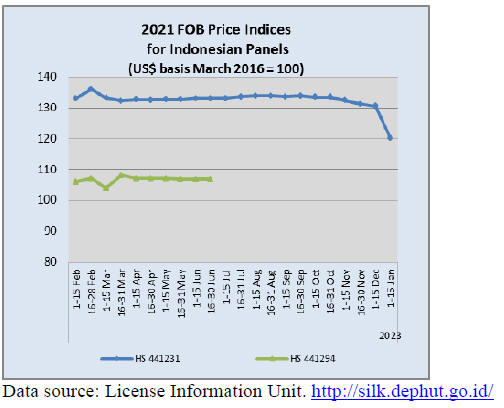
5.
MYANMAR
UNSC expresses “deep concern”
In December 2022 the United Nations Security Council
(UNSC) yesterday adopted its first resolution on Myanmar
in more than seven decades, expressing “deep concern” at
the situation that has engulfed the country since the
military take over in February 2021. The resolution was
adopted with 12 of the 15 members of the UNSC in favor,
while India, China and Russia abstained.
See:
https://press.un.org/en/2022/sc15159.doc.htm
Fading prospects for forest product exports
As a result of the ongoing international pressure and
restrictions on trade in products from Myanmar exports of
timber have been affected.
The cumulative result of the US Burma Act (recently
revised), OFAC and FATF resolutions on financial
transactions and action by the EU parliament have had a
striking impact, not only timber trade but also the entire
business sector.
In addition to external action there are also internal factors
which have slowed the timber trade. The Myanma Timber
Enterprise (MTE) is the sole and official supplier of logs
to the sector but the MTE is facing difficulties to transport
logs from the extraction sites to Yangon where many
processing mills are located because of the security threat
from the anti-government forces.
Changes to export regulations have also undermined
exports of wood products. In August 2022 an order was
issued revising the definition of type of wood products.
It was decreed that sawnwood greater than a crosssectional
area of more than 24 square Inch (for example
width 8-inch and thickness 3-inch or width 12-inch and
thickness 2-inch) shall be regarded as rough sawn and
exports are prohibited. As a result squared logs and
veneer flitches cannot be exported and this has cut into
export earnings.
Annual export earnings from timber exports have fallen to
around US$10 million over the past three years according
to data from the of Ministry of Commerce.
See:
https://myanmar-now.org/en/news/us-house-passes-burmaact-with-new-amendments,
and
https://www.en.etemaaddaily.com/world/international/fatf-addsmyanmar-to-list-of-high-risk-countries:121346#:~:text=Mon
24Oct 2022
Foreign investment flows
The Myanmar Investment Commission has reported it
approved 59 foreign investment projects from eight
countries between April and December of the current
financial year 2022-2023.
The country attracted capital of US$1.46 billion which
included expansions by existing enterprises. The sectors
that attracted most investment were agriculture,
manufacturing, power, real estate and services.
Singapore was the top source of FDI with 14 Singaporelisted
enterprises investing US$1.154 billion into
Myanmar. Hong Kong SAR was the second largest
investor with an estimated investment of around US$165
million for 12 projects. China was the third largest
investor at US$95.6 million for 27 projects.
From 1 February 2021 the Thilawa SEZ attracted capital
flows for expansions, around US$100 million and from
one new enterprise. The majority of the investments are
for cement and pharmaceutical manufacturing.
See:
https://www.gnlm.com.mm/mic-bags-59-foreign-projectsworth-1-46-bln-in-nine-months/
6.
INDIA
GDP set to slow
The Indian government expects economic growth to have
slowed in the financial year ending March. GDP is
forecast to rise 7% this fiscal year compared with 8.7% the
previous year, according to the Ministry of Statistics. This
is much lower than the government's earlier forecast of
8%-8.5% but above the central bank's projection of 6.8%.
India's economy rebounded after COVID-19
restrictions were eased around mid-2022 but the Russian
invasion of Ukraine has spurred inflationary pressures
prompting the Reserve Bank of India (RBI) to reverse the
ultra-loose monetary policy it adopted during the
pandemic years.
The RBI increased interest rates by 2.25% between May
and December in an aggressive response to rising inflation
which hit a high of 7.79% in April. In other news, higher
commodity costs and a weaker rupee have caused a
deterioration of the trade balance. The rupee hit record
low last year, plunging more than 11% against the US
dollar.
See:
https://www.hurriyetdailynews.com/india-gdp-growthforecast-to-slow-to-7-percent-179954
According to the OECD, despite slower growth, India
is
set to be the second-fastest growing economy in the G20
in FY 2022-23, even with decelerating global demand and
the tightening of monetary policy to manage inflationary
pressures.
See:
https://www.oecd.org/economic-outlook/november-2022/
Welcome dip in inflation
The annual rate of inflation based on the Wholesale Price
Index was 5.85% in November 2022 compared to 8.39%
in October 2022. The decline in November inflation was
primarily contributed by fall in prices of food, basic
metals, textiles, chemicals and paper products.
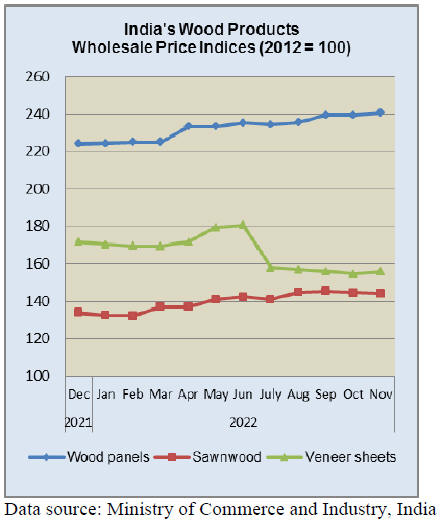
The wholesale price index for manufacturing declined
in
November to 141.5. Out of the 22 NIC two-digit groups
for manufactured products, 11 groups saw an increase in
prices while 10 groups declined. The increase in price was
mainly contributed by food, fabricated metal products,
non-metallic mineral products and machinery and
equipment.
Declines were recorded for basic metals, textiles,
chemicals, paper products along with rubber and plastics
products.
See:
https://eaindustry.nic.in/pdf_files/cmonthly.pdf
Trade deficit widens
The latest trade data released by the Ministry of
Commerce and Industry show India’s exports were worth
almost US$32 billion in November 2022 while imports
were valued at almost US$56 billion. Exports grew by
0.6% over November 2021 while imports grew by 5.4%.
The rise in the value of imports could have been higher if
it was not for the rise in imports of Russian crude oil
produced in the Arctic region offered at steep discounts
after Europe stopped oil imports from Russia.
Bio-fuel from planted degraded land
India is looking to replicate global models to
commercially grow cactus on degraded land to produce
bio-fuel, food, fodder and bio-fertliser. This has been
discussed in the Ministry of Rural
Development. Government estimates show degraded land
increased to 97.84 million hectares in 2018-19 from 96.32
million hectares in 2011-13.
The government is committed to increased farmers’
income and cultivation of cactus could significantly lift the
economies in states which have vast tracts of degraded
land. Rajasthan, Maharashtra and Gujarat are the top three
states with most degraded.
See: https://economictimes.indiatimes.com/news/india/govtmulls-
cactus-plantation-on-degraded-land-for-biofuelfood/
articleshow/96407372.cms?from=mdr
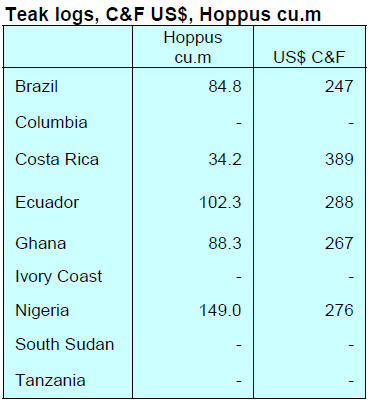

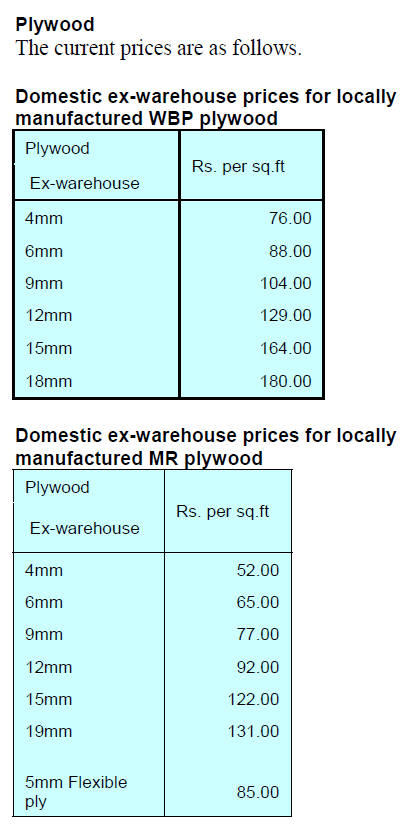
7.
VIETNAM
Wood and Wood Product (W&WP) Trade
Highlights
According to data provided by Vietnam General Statistics
Office, Vietnam’s W&WP exports in December 2022
reached US$1.16 billion, down 1.2% compared to
November 2022 and down 19% compared to December
2021. Of this, export of wood products (HS 94) accounted
for US$782 million, up 2.8% compared to 11/2022, but
down 27% compared to December 2021.
In 2022 the accumulated W&WP exports totalled US$15.8
billion, up 7% year-on-year. WP exports alone amounted
to US$10.9 billion, down 1.3% compared to 2021. Over
US$1 billion was contributed by exports of NTFPs. The
total export earnings from forest products is reported at
US$16.8 billion.
Vietnam's W&WP export to South Korea in December
2022 reached US$102 million, up 11% compared to
December 2021. In 2022 the W&WP exports to the
Korean market are estimated at US$1.02 billion, up 15%
compared to 2021.
Exports of woodchips in December 2022 were valued at
US$220 million, up 58% compared to December 2021. In
2022 the total export of wood chips is estimated at US$2.7
billion, up 55% compared to 2021.
W&WP imports in December 2022 totalled at US$230
million, up 4% compared to November 2022. In 2022
Vietnam spent US$3.052 billion to import W&WPs from
over 100 sources with the year-on-year growth of 4%.
With the great surplus of export over import the forestry
and wood industry has been greatly appreciated for
substantial contribution to the national economic balance
and sustainable growth.
According to Vietnam General Statistics Office in the first
11 months of 2022 the area of newly planted forests is
estimated at 26,600 hectares, up 5% over the same period
last year.
The number of scattered trees planted during the year is
reported at 96.5 million, up 5%; the volume of harvested
wood is estimated at 34.6 million cu.m, up 7%; the loss of
forests due to violations and forest-fires was reported at
1,047.6 ha, year-on-year down 58%, of which burnt forest
area was 37.9 ha, down 97%; the violated area was
1,009.7 hectares, down 2%.
Woodchip export increase significantly
In the first 11 months of 2022 woodchip exports to China,
the top destination, were worth US$.7 billion, up 62%
over the same period in 2021 followed by the Japanese
market (US$634.6 million, up 38%), South Korea
(US$56.3 million, up 55%), Taiwan P.o.C (US$17.1
million, up 19%).
China increased imports of wood chips from Vietnam not
only for the pulp and paper industry, but also for pellet
production. In addition to Chinese market, the growth of
woodchip export to South Korea and Japan also increased
as these 2 countries continue to have the transition from
coal power to clean electricity, including biomass power.
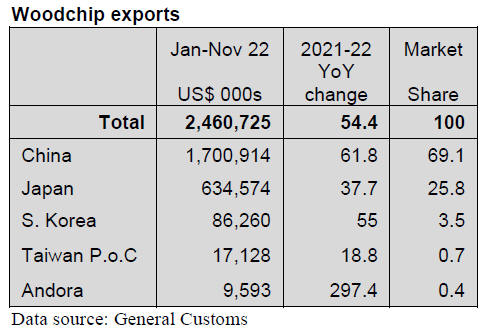
Log and sawn wood imports in 2022
In December 2022 Vietnam imported 505,700 cu.m of
logs and sawnwood, worth US$177.0 million, up 4.4% in
volume and 4% in value compared to November 2022.
Compared to December 2021 there was an increase of
35% in volume and 20% in value.
In 2022, in total, the imports of logs and sawnwood to feed
manufacturing industries are estimated at 6.04 million
cu.m, worth US$2.28 billion, down 4.5% in volume and
down 6% in value compared to 2021.
Due to the decreased demand for interior and out-door
furniture in the US and EU markets Vietnam’s imports of
non-tropical softwood and hardwood, including pine,
poplar, oak, ash, birch, beech declined. In the contrast, the
imports of tropical hardwood, such as tali, padouk, pachy,
mahogany to meet local demand increased.
Log and sawnwood imports in the first 11 months of 2022
In the first 11 months of 2022 log and sawnwood imports
amounted to 4,552 million cu.m worth US$1.72 billion.
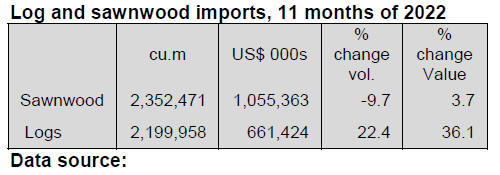
In 11 months of 2022 the mean price of imported logs and
sawn wood was US$380.5/cu.m CIF, up 12% year-onyear.
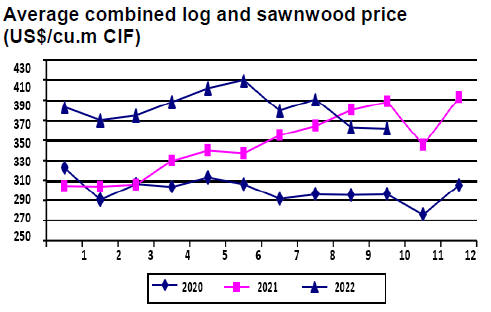
Log and sawn wood suppliers
In the first 11 months of 2022 the volume of raw material
imported from major suppliers such as the US, China,
Thailand, Brazil, Chile and New Zealand decreased
compared to the same period in 2021. In the contrast,
imports from several sources uch as the EU, Cameroon,
Papua New Guinea, Laos, Nigeria and Congo increased.
Log and sawnwood imported from the US accounted for
12% of total imports in the first 11 months of 2022,
reaching 645,300 cu.m worth US$307.9 million, down
0.5% in volume but up 3% in value over the same period
in 2021.
Imports from China decreased by 35% in volume and 12%
in value and amounted to 613,500 cu.m, worth US$333
million equal to 11% of total imports.
In addition, imports from some other markets decreased:
from Thailand imports dropped 2%, Brazil by 32%, Chile
by 25%, New Zealand by 33% and Uruguay by 8%.
Conversely, imports from the EU increased by 1.5% in
volume and 15% in value over the same period in 2021
reaching 775,600cu.m, worth US$258 million and
accounting for 14% of total imports.
The imports of tropical hardwood from traditional
suppliers experienced significant growth with Cameroon
up by 36%, Papua New Guinea by 88%, Laos by 73%,
Nigeria by 64%, Congo by 86%, Hong Kong by 85% and
Argentina by 27%.
Positioning Vietnamese brands on the global map
Vietnamese made wooden furniture brands are still almost
"unknown" in the international market since they are
mainly traded through foreign enterprises. Changing this
can bring higher value to wood and furniture products and
contribute to the positioning of Vietnamese wood and
furniture brands on the global map.
Brands unknown to global consumers
According to the Department of Forestry more than 2,600
enterprises are exporting wood products. Of these, there
are 750 FDI units and 1,850 domestic units. Vietnamese
wood product brands are well positioned in the domestic
market but building brand image in international markets
is a challenge.
The domestic market has identifiable wooden furniture
brands such as Dong Ky Wood Village - Bac Ninh; Ho
Nai - Bien Hoa furniture craft village and the brands
owned by enterprises such as Hoang Anh Gia Lai Wood
JSC (Gia Lai); An Cuong Wood JSC (Binh Duong); Hoa
Phat Furniture JSC (Hung Yen); and Thuan An Wood JSC
(Binh Duong).
In addition to meeting domestic consumption of about
US$3-4 billion/year Vietnam's wood industry exports, on
average, generate more than US$15 billion per year
making Vietnam the 5th largest suppliers in the world, 2nd
in Asia, 1st in Southeast Asia. The export markets for
Vietnamese furniture have expanded from 60 countries
and territories in 2008 to more than 120 countries and
territories by 2022.
However, in export markets Vietnamese wood and wood
products have only won the trust of traders, wholesalers
and agents but have not yet made an impression on, or
attracted individual consumers.
According to the Department of Forestry the reason for
this situation is that a branding policy in the wood
processing industry has not been implemented.
Vietnamese wood and wood product enterprises do not
have experience and lack resources to develop overseas
sales systems which are the foundation for building a
brand image. In addition, developing overseas markets
requires large-scale production capacity but few
Vietnamese enterprises can meet this requirement.
Branding to add value
According to Nguyen Quoc Khanh, Chairman of the
Handicraft and Wood Industry Association of HCM City
(HAWA) and AA Company, Vietnamese enterprises need
to change their mindset of making money by being
diligent in production but need to build their brand.
Building a brand helps businesses develop their vision and
orientation, increase the customer base, ease access to
international markets and optimise profits.
A brand will increase a product’s commercial value
contributing to the increase in export earningsand position
the furniture industry of Vietnam on the global map.
Nguyen Van Dien, Director of the Forestry Production
Development Department - Ministry of Agriculture and
Rural Development, said that the Ministry of Agriculture
and Rural Development is assigning the Department of
Agricultural Product Processing and Market Development
to develop a decree on the branding of essential
agricultural products. "When this decree is issued
enterprise a branding process will be possible because it
can be done methodically and scientifically thereby
achieving better results," said Dien.
Additionally, to support businesses in developing their
brands, the Department of Forestry proposed the Ministry
of Foreign Affairs direct overseas trade counsellors to
support wood processing enterprises in building and
developing Vietnamese wood brands abroad.
See:https://antidumping.vn/position-vietnamese-wood-andfurniture-brands-on-the-global-map-n25277.html
8. BRAZIL
Confidence rises in the furniture sector
The Industrial Business Confidence Index (ICEI) is the
weighted average of two components: the businesses
assessment of the current and future state of their own
companies and the assessment of the current state and
future prospects for the Brazilian economy.
A total of 2,033 companies were consulted in December
2022 to prepare the index of which 803 were small-sized,
737 medium-sized and 493 large companies.
According to entrepreneurs' assessment the Brazilian
economy affected industrial confidence in December.
While four sectors made the transition from a state of
confidence to lack of confidence however enterprises in
the furniture sector made a transition from lack of
confidence to confidence.
See: http://abimovel.com/confianca-do-empresario-sobe-nosetor-
de-moveis-mas-cai-nos-demais/
Multiplier training in community forest management
Forest Management for timber production has been carried
out for over twenty years by traditional community
associations in the state of Amazonas with the support of
the Mamirauá Sustainable Development Institute (IDSM).
In November 2022, 15 professionals from different
regions of the State participated in training of multipliers
on community forest management in the municipality of
Tefé, in the Amazon Region.
Participants discussed the history of occupation of the
Mamirauá Sustainable Development Reserve; the
organisation of the riverine populations and their
involvement in management activities; forest management
techniques, environmental legislation, stock survey among other topics.
The event aimed to expand the experience with
community forest management in floodplain areas through
training multipliers who expand knowledge of
methodologies adopted by the Mamirauá Institute to other
regions of the Amazon. Mamirauá is a social organisation
backed by the Ministry of Science, Technology and
Innovation (MCTI).
See: https://www.mamiraua.org.br/noticias/instituto-mamirauarealiza-
curso-multiplicadores-manejo-florestal-comunitario-
Furniture association - prospects for 2023 are uncertain
The Bento Gonçalves Furniture Industry Union
(Sindmóveis) has warned of likely impacts from the
effects of global political and economic instability.
According to Foreign Trade Statistics the revenue
generated by the more than 300 furniture companies in the
region will end 2022 with a nominal retraction of 3.5%
compared to that of 2021. Yet, this performance is 40%
higher than registered in 2020 and 55% above 2019 (the
year before the pandemic).
According to Sindmóveis the reason behind the drop in
revenue was weak international demand. Sales between
January and November 2022 fell over 25% year on year.
The Bento Gonçalves furniture cluster represents more
than 300 companies, generating 6,646 jobs and revenues
of R$2.6 billion between Jan-Oct/2022; R$3.2 billion in
2021, R$2.2 billion in 2020 and R$2.0 billion in 2019.
Prospects for 2023 are uncertain because a great deal will
depend on the measures adopted by new government
such as credit expansion, more competitive interest rates
and unemployment rate reduction which are factors that
can foster sales in the domestic market.
See:
https://www.sindmoveis.com.br/como-o-polo-moveleiro-debento-devera-encerrar-2022/
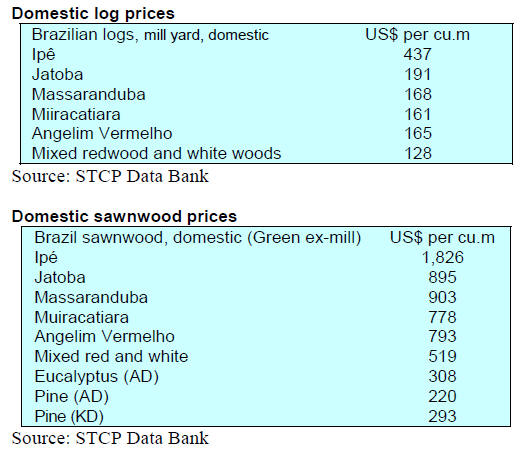

9. PERU
SERFOR promotes production for public purchases
SERFOR (National Forestry and Wildlife Service)
recently exhibited a variety of locally made wood products
such as doors and school furniture. It also provided a
series of technical specifications for wood products
acceptable for government procurement.
The technical sheets have been approved by the Central de
Compras Públicas (Perú Compras), a public body attached
to the Ministry of Economy and Finance and whose
mission is to optimise public procurement of domestically
made products.
The specifications include species that can be used.
SERFOR, through the Directorate of Promotion and
Competitiveness, is also supporting production by small
and medium-sized companies for government purchases.
OSINFOR and GERFOR Loreto exchange experiences in forest inspection
Specialists from the Forestry and Wildlife Resources
Supervision Agency (OSINFOR) and the Forestry and
Wildlife Development Management (Gerfor) recently
participated in an event to share experiences on inspection
and sanctioning in the forestry sector.
The specialists were able to share their experiences in the
activities under their jurisdiction, the execution of
complementary measures directed by OSINFOR and the
difficulties that arise in complying the various regulations.
Action Plan for the shihuahuaco and tahuari
SERFOR has published its "Action Plan” for the
implementation of CITES regulations pertaining to
shihuahuaco (Dipterix genus) and tahuari (Handroanthus
genus). At the Nineteenth meeting of the CITES
Conference of the Parties held in Panama City last
November the genera Dipteryx and Handroanthus were
added to CITES Appendix II.
The Action Plan presents four components to be
implemented by SERFOR:
--- Regulatory improvements to enable the proper
incorporation of these two species into CITES
--- Collection of information on the species for
sustainable management decision-making
--- Evaluation of the existence stocks in the forest, in
mill yards and in storage.
--- Strengthening capacity for the sustainable
management of these resources.
See:
https://www.gob.pe/institucion/serfor/informespublicaciones/3770000-propuesta-del-plan-de-accion-para-laadecuada-implementacion-de-la-inclusion-del-shihuahuaco-andtahuari-in-appendix-ii-of-the-cites-years-2023-and-2024
Communities in Ucayali learning to use drones
OSINFOR has reported that 36 leaders of native
communities in Ucayali have been trained in the use of
drones and in community forest control and surveillance in
order to strengthen the prevention of forest crimes.
OSINFOR specialists traveled to Ucayali to provide
theoretical and practical training to the communities on the
topics of Forest Crimes, Surveillance and Community
Forest Control. Community leaders were instructed on the
use of drones in order to use them for forest surveillance..
In related news, OSINFOR has conducted a course to
facilitate the identification of the main timber forest
species in the Amazon for 20 regional forest authorities in
Ucayali regions in order to contribute in the planning,
review and execution of forestry activities.
Course participants were trained by specialists to
understand the dendrological characteristics of the main
families, genera and forest species. The course
"Identification of timber forest species" had the technical
support of the German International Cooperation, GIZ,
through the ProAmbiente II programme.


|